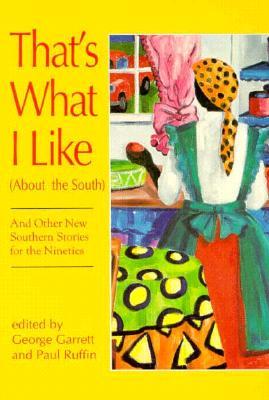As traditional as a Chinese restaurant, as homegrown as a Subaru, as agrarian as a fax machine, as Celtic as a computer, as handcrafted as cable television, as hospitable as an eight-lane expressway, as Baptist as a drug deal, as Presbyterian as neo-pagan worship, as Episcopalian as a lesbian sermonette, and as pious as an abortion mill, the contemporary South is an overheated but air-conditioned land of profound corruption, Swedish luxury sedans, and political fatuity that exemplifies everything wrong with America. Why else would a small-town boy from Arkansas, raised on wholesome values, fit in so well with the high-minded leaders of New York, Hollywood, and Haiti?
But beneath the surface of ugliness, lies, and conformity, there remains a remnant of authenticity that may be isolated privately or even demonstrated publicly. In the realm of literary culture, the short story, since Poe and Longstreet and Thorpe, has been a Southern specialty of international renown. In our century, names such as William Faulkner, Katherine Anne Porter, Caroline Cordon, Eudora Welty, Robert Penn Warren, Andrew Lytle, Flannery O’Connor, and Peter Taylor come to mind first perhaps, but the import of the present volume is that the literary tradition of the South remains a vital one, even in the shadows of those masters and mistresses of the art.
Readers of this journal will be interested to know that two pieces originally published in Chronicles in March 1991—Fred Chappell’s story “Ancestors” and Madison Smartt Bell’s essay “Time and Tide in the Southern Short Story”—are included here. They are joined by a number of stories from a special 1990 issue of Texas Quarterly, as well as by others from elsewhere—31 in all. The collection is imposing, “diverse,” and impressive, striking sparks in many directions, though I will restrict myself here to commenting upon only a few of them. After all, Fred Chappell’s introduction, “The Good Songs Behind Us: Southern Fiction of the 1990’s,” says what needs to be said so effectively that further comment is hardly necessary.
Still, I would like to note a few works that seem particularly remarkable, ones which are likely to survive the publication even of That’s What I Like to become set pieces in writing classes and to be featured in subsequent anthologies of the short story. Furthermore, these stories show in various ways something distinctively Southern that survives in spite or even because of so many changes. Fred Chappell’s “Ancestors,” quite possibly the finest work in this collection, might be called an example of “magic realism” or of Confederate science fiction. In giving a new meaning to the phrase “opening old wounds,” he provides a perspective upon the past by vividly imagining a future in which that past is not only not forgotten, but possibly even revised, as the Civil War eternally returns. That war is present also as an ironically baleful background in Alison Hagy’s “The Field of Lost Shoes,” in which the battlefield of New Market provides a contemporary setting for the crisis of a love affair.
Or perhaps Madison Jones’s “Rage” is the finest work in this collection. At the end, Herman, the black protagonist, “looked . . . like the devil himself,” a phrase that hints at a larger meaning about the nature of rage. Madison Jones’s story is notable for its disarming purity of diction and for a moral awareness reminiscent of those honorary Southerners, Hawthorne and James—qualities we have come to expect from one of our nation’s finest writers. “Rage” is notable, too, as a story about a black man written by a white man—a story as politically incorrect as it is morally sound.
But then again, something very different, Jill McCorkle’s “Final Vinyl Days,” is also a contender as a favorite, making meaning as it does from the chaos of mass culture. Its narrator is agonized by progress, for what compact disc has the authenticity of an LP of oldies but goodies? Love is as hard to find as the good old days of the late 60’s and early 70’s: “Where were the real women? Where was Grace Slick?” The Southern longing for days gone by has rarely been so poignantly parodied as in this sad and funny story.
R.H.W. Dillard’s contribution (which lends its title to that of this collection) is something else, a postmodern send-up that makes one think of Borges and Nabokov and Berger before reflecting that Faulkner is here, too, as everywhere. Trying to get the “gender” of Roy and Shirley, respectively, and to count all the titles of Southern works woven into the text of “That’s What I Like (About the South)” is so much fun that reading, yet once more, feels good.
The pleasure of the text is not Schadenfreud, though, even when stories written from the realist tradition put us through compelling unpleasantness. William Mills’ “The Commuters” is a glimpse of hell that seems frighteningly like familiar experience. The severity of its truth gives us an existential insight as well as the satisfaction of knowing something that is keenly rendered. Clay Reynolds’ “Mexico” does scrupulously and powerfully just what the movies can’t do at all, in a tale of roughneck violence that produces an epiphany. Alan Weir’s “Bastard” is a superb story of highly particular recollection, of a coming of age understood in hindsight and made accessible by the telling.
So much success and so much variety are self-recommending to any reader hungry for the good stuff; and I have cited only a few of many pieces. The demonstrated craftsmanship says much about the possibilities of writing in and about and of the South, which somehow retains a cultural identity even as it is betrayed from within and transformed from without. The reading, like the writing, helps. So what else is new?
[That’s What I Like (About the South): And Other New Southern Stories for the Nineties, edited by George P. Garrett and Paul Ruffin (Columbia: University of South Carolina Press) 421 pp., $34.95]

Leave a Reply